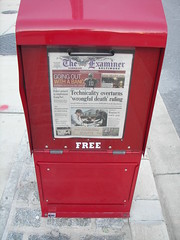Another museum story
Paul Johnson comments in his Bosconet blog on a recent Baltimore Examiner story, "Crime a stumbling block for city’s tourism industry." (Note that I discovered that on Saturdays the Baltimore Examiner does distribute papers to at least some of their news-stand boxes. The DC Examiner doesn't do this--at least not in the areas I habituate.)

For one, the headline is bad. The story is about fall off in patronage of the Sports Legends Museum specifically, even other examples provided in Baltimore didn't experience a drop in attendance. So the hadline needs to refer only to the Sports Legend Museum. Plus the article's evidence doesn't support the argument about crime.
Paul writes, in "Crime as an excuse":
1. The location is removed from the inner harbor and most of the other traditional tourist destinations people think of when they think of Baltimore.
2. Attendance is probably directly affected by attendance to home Orioles games. (and this is mentioned in the article as a problem. Since the O’s continue to perform poorly attendance has suffered and the Sports Legends Museum says this is a contributing factor to reduced attendance)
3. The audience the museum appeals too is somewhat limited (it focuses on Baltimore sports).
Plus it's likely that the audience that the museum appeals to skews to men (remember the great movie "Diner," speaking of Baltimore) who are less likely to attend museums. Plus, how does the museum work to attract attendees the 275 days of the year that they aren't proximate to football and baseball games (not to mention that the number of people willing to pack in a museum visit plus a game day experience is probably smaller than you think).
On the other hand, the Senator John Heinz Pittsburgh Regional History Center, added a large permanent exhibit on sports history (baseball, football, hockey), the Western Pennsylvania Sports Museum, and experienced attendance increases of up to 40% compared to the previous footprint of the museum. (In fact this is something I am pondering while considering issues around the revivification of DC's City Museum.)
I think this is an issue of placemaking and connectedness, about the layering of attractions, which I discussed in the context of the Gallery Place-7th Street NW-Verizon Center-Reynolds Center area of the city last month, in the blog entry "Layering, location, and business failure as an indicator," as well as marketing.
Index Keywords: museums; cultural-heritage-tourism



0 Comments:
Post a Comment
<< Home